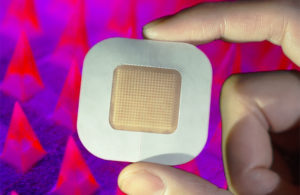Could treating diabetes someday be as simple as slapping on a patch? A UCLA-led research team thinks so, and it’s seeking FDA permission to prove it.

Their creation is a coin-sized (about 5 cm2), adhesive polymer patch with microneedles. The pyramid-shaped microneedles are about 400 microns wide at the base and 900 microns tall and penetrate the stratum corneum, the outer layer of the skin. When the interstitial fluids in the skin reach hyperglycemic levels, the phenylboronic acid units within the polymer matrix promote swelling of needles and release the insulin preloaded into the matrix.
Because the researchers created the patch through a molding and UV light-curing process that doesn’t damage the insulin, about a fifth of the microneedles’ weight is insulin — enough to enable clinical use, according to the researchers’ paper in the Feb. 3 edition of the journal Nature Biomedical Engineering. Studies showed that the patches maintained the bioactivity of the insulin for more than 8 weeks at room temperature.
“There’s a high amount of insulin inside, and we’re making the whole needle matrix glucose-responsive,” Gu said in a recent interview with our sister site Medical Design & Outsourcing.

